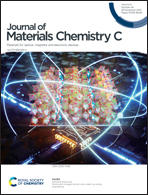Synthesis and characterization of solution processable, high electron affinity molecular dopants†
Abstract
p-Type molecular dopants are a class of high electron affinity (EA) molecules used to ionize organic electronic materials for device applications. It is extremely challenging to ionize high-performance, high-ionization energy (IE) polymers because the dopant molecule needs to be compatible with solution processing. Here, we describe the synthesis and characterization of two new solution processable molecular dopants with the highest EA values yet reported. These molecules, based on the parent hexacyanotrimethylenecyclopropane (CN6-CP) structure, achieve solubility by the substitution of one or more of the cyano groups with esters, which both reduces the volatility relative to CN6-CP and allows for solution processing. The efficacy of these new molecular dopants, which have EA values up to 5.75 eV with respect to vacuum, was tested by performing sequential solution doping experiments with a series of thiophene and alternating diketopyrrolopyrrole polymers with IEs ranging from 5.10 eV to 5.63 eV. For completeness, the new dopant results are compared to a previously reported tri-ester substituted CN6-CP analogue with an EA of 5.50 EV. The increased EA of these stronger dopants induces a 10–100 fold increase in film conductivity and saturation of the conductivity at 15–100 S cm−1 for almost all polymers tested. These new dopant structures enable controlled solution doping at high doping levels for most alternating co-polymers of interest to the organic electronics community.



 Please wait while we load your content...
Please wait while we load your content...
